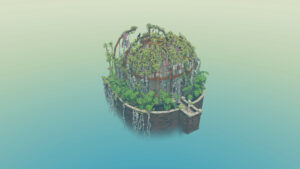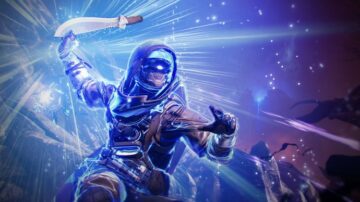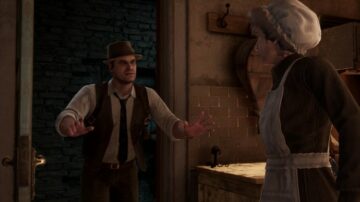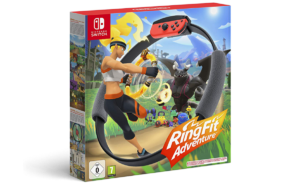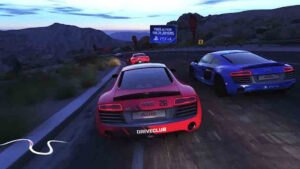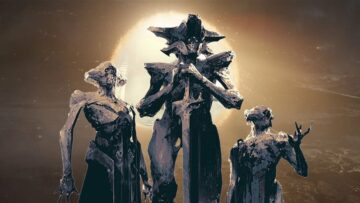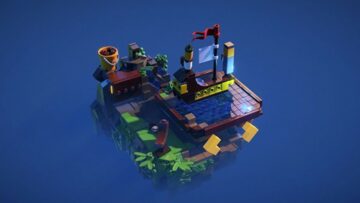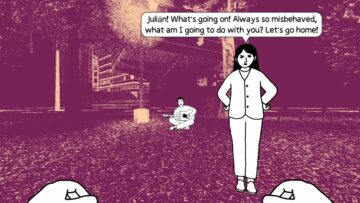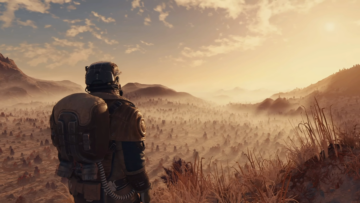Even just looking at Sea of Stars makes one thing clear: it wants to join the ever-growing “I love SNES RPGs” fanclub. We’ve seen a bunch of those in recent years; games that lovingly recreate the irresistible sprites and 16-bit vistas, while slapping on some upbeat chiptunes to feed you turn-based battles for hours. Sea of Stars does that too, sure, but it’s also so much more than that. Perhaps the best compliment I can give to Sea of Stars is that it rewound time and turned me back into a little kid, reminding me of playing those old-school classics nose-to-screen on a CRT, or curled up under the covers with my muted DS well past bedtime.
The thing that sets this love letter apart, for me, is just how well-read (well-played?) it is. Sea of Stars rips inspiration from all directions – not just from the obvious Chrono Trigger – tosses those inspirations into a blender, and the resulting cocktail is smart, charming, and constantly surprising. More importantly, the game also never feels derivative, balancing old and new on a knife’s edge.
Let’s take a step back for a second, though. Sea of Stars follows two fated warriors – Zale and Valere – who were born on the summer and winter solstices, and thus, are destined to spend their lives fighting beasts left over from a generations-old conflict. These types of RPGs are often about lost innocence and painful experience, and Sea of Stars follows suit with a cute introduction that has you battling cave critters and skeletons and a weird mole child. The stakes soon get significantly grimmer – no spoilers here – but Sea of Stars only stumbles at those more dramatic turns.
For what it’s worth, the game executes wildly different tones really well, oscillating between pirate ship comedy, spooky haunted house, epic family-friendly fantasy and, err, space-time-bending cosmic weirdness. That’s partly thanks to a staunch attention to detail. Aforementioned pirate friendo rips off his shirt the first time we meet him, and if you look closely enough, you can see his pixelated pecs bulge – not that I was staring. Travelling historian Teaks is so fascinated by our legendary duo that her animation zips all around them, in and out of existence, to examine them from every angle.
Those are endearing character moments, but the game also painstakingly authors even the seemingly cursory scenes. Entering one enemy lair requires you to jump from up high and through a glass ceiling as the sickest battle theme – sometimes courtesy of Chrono Trigger’s composer Yasunori Mitsuda – thumps in the background. Chef’s kiss. Job done. No notes. I’m sufficiently too pumped for this fight against enemies that arguably don’t invite such an epic introduction.
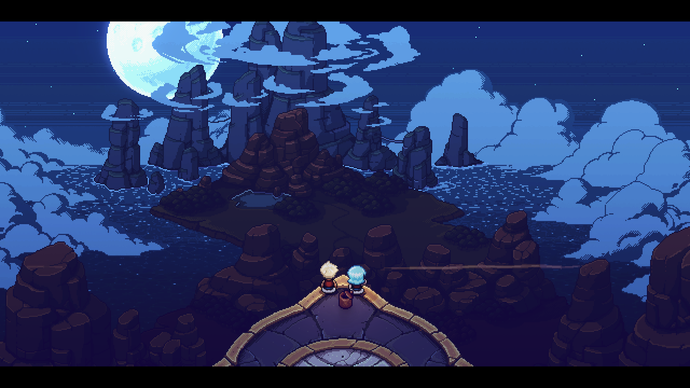
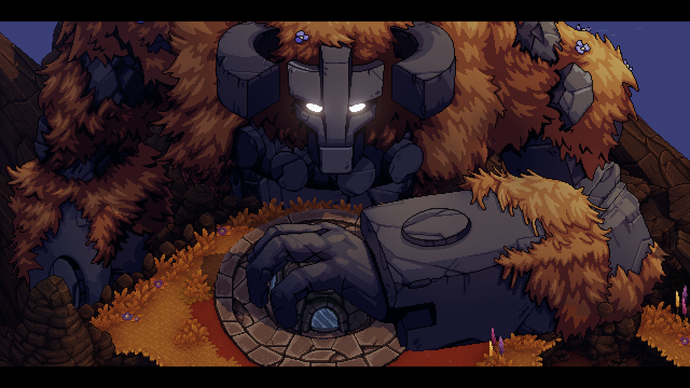

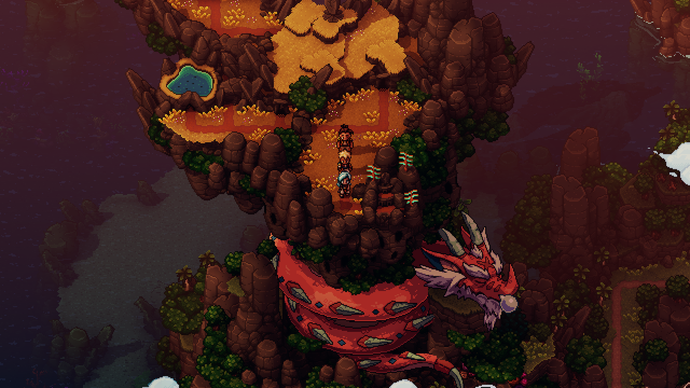
The one mood that Sea of Stars can’t pull off is dramatic and/or sad. Your merry party – plus all the colourful side characters you meet – is great fun, full of jokes and expressive animations. The problem is that moments where you peek behind the curtain and into their psyches are too few. How do Valere and Zale feel about what’s transpired? Who knows!? They don’t talk about world events much. One early-game party member is a badass assassin who travels via green portals and covers half her face with a mask. Mysterious, right? Our protagonists aren’t really interested in who she is, what she wants, or why she’s motivated to help us, though. We only learn about her at around the 30-hour mark, around 20 hours after her introduction, give or take a few hours. When the dire stuff does happen, it’s just a little hard to care about this party because they give us so little to chew on.
That’s no bother, though, because Sea of Stars is a 30-40 hour RPG and you spend the vast majority of that time doing, well, what you’d expect: fighting and exploring. Combat channels Chrono Trigger (yes, the obvious one) since battles are set in the same locations you explore, and positioning is given heavy importance. Some skills can rejig enemy placements, making the unfriendly party susceptible to AOE moves. Although in the second-to-second action, Sea of Stars owes more to Mario’s RPGs, as timed button presses can block/deal extra damage, and some spells can be deflected endlessly for a mega damage boost.
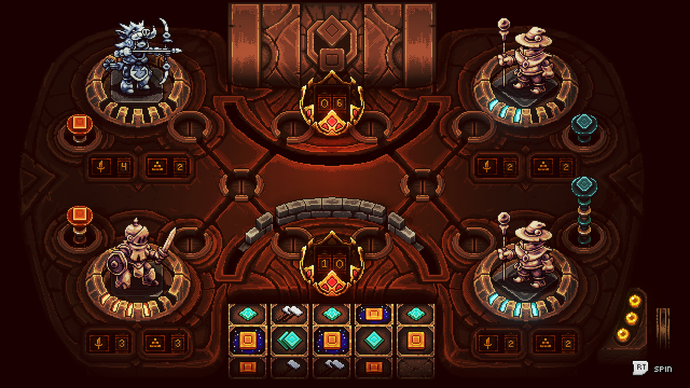
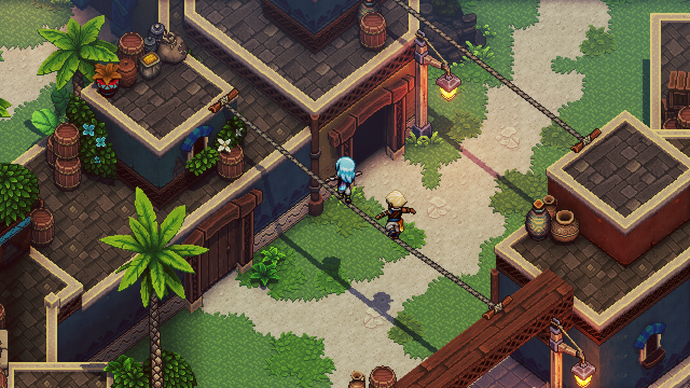
Fights frequently feel more scaled back than other turn-based contemporaries, in a good way. There aren’t an overwhelming number of status effects, elemental weaknesses and stats that – let’s be real – you don’t know the purpose of. Instead, when enemies are charging up a particularly strong attack, several signs (“Locks”) float above their head that indicate which damage types can disrupt their power move. If two sword signs appear, for instance, then you need to hit them with a blade twice to cancel the attack. Breaking these Locks in an efficient order – and saving precious turns as a result – added some nice puzzling to every encounter. It’s a smart way to kind-of-remix the “conditional turn-based” systems found in Final Fantasy X or Blue Dragon.
A stripped-back approach also extends to your character building choices. Sea of Stars doesn’t let you alter your character’s class; their skills and spells are locked in. But everytime you level up, you can give one stat an extra nudge. Since the level cap is firmly locked at 30, damage points and health pools never become incomprehensible, so every tiny stat-boosting decision you make is felt. For example, I invested in buffing my portal assassin’s attack numbers and mostly neglected any of her defensive needs, meaning she was just as deadly and vulnerable as her dual-daggers.
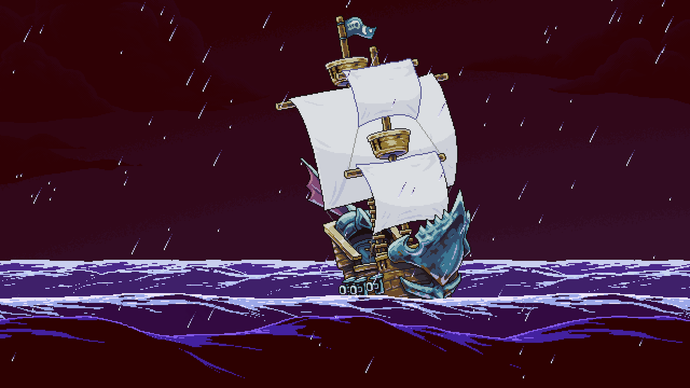
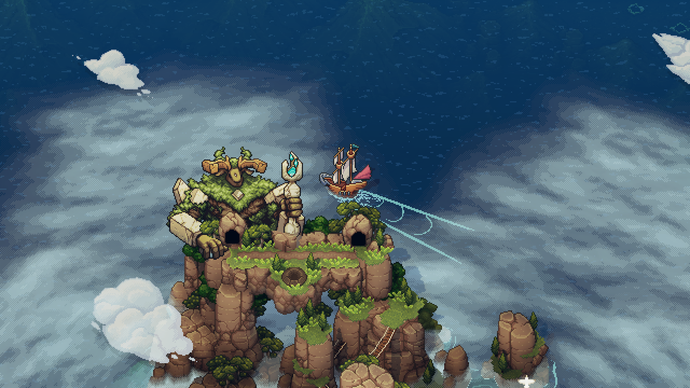
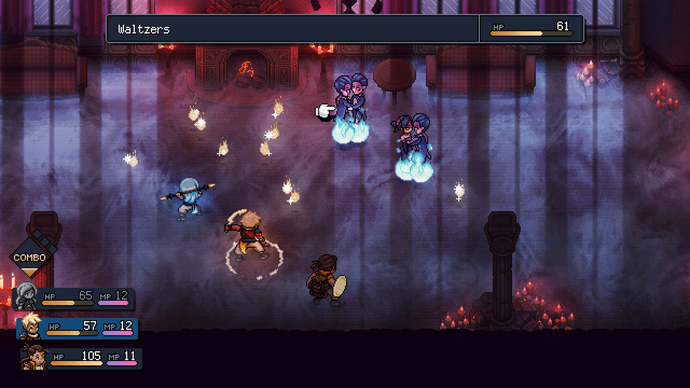
Despite the sometimes lengthy animations, I was always switched on and very much active during fights thanks to a constant ticking countdown (the Locks), the need to always be present for a follow-up attack (the timed button presses), and the very Chrono Trigger-esque party combo moves that I haven’t even mentioned yet. These don’t add drastically to your strategic options, but they’re always a pretty spectacle. Stitching it all together, developer Sabotage Studio has created maybe the most engaging turn-based battle system I’ve played in years. You’re always racing time, choosing between health and damaging pawns and delaying a boss’ turn.
When you’re not swinging swords and throwing around moon boomerangs, you’re probably out exploring the beautiful world, which basically feels like peeking into a teenager’s dream SNES game. There are underwater fish villages, a snoozing dragon coiled around a mountainside and so, so much more all happily thrown together. But for the next round of Spot The Influence, Sabotage reworks the traversal pleasures found in the oft-forgotten Illusion of Gaia, letting you climb up ledges, jump from roofs, swim from the very beginning – which sounds standard but totally transforms the treasure-hunting opportunities in these types of games. Sea of Stars goes one step further with grapple hooks and other handy tools.
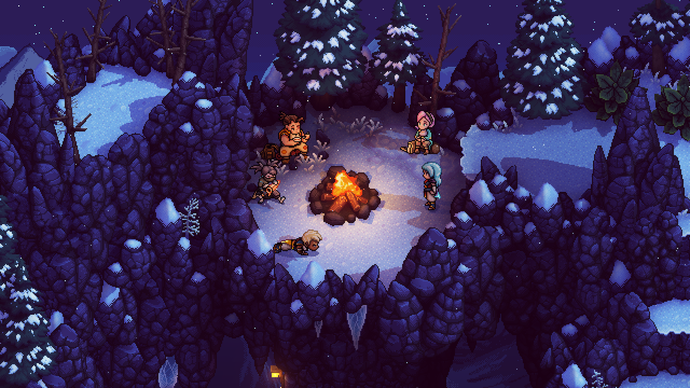
Movement options aren’t just here to make the A-B treks less monotonous. Exploring the game’s (sometimes shockingly) dense dungeons felt two steps removed from playing a top-down Zelda-like. Puzzles aren’t nearly as complex and the corridors don’t fold in on themselves in quite the same way, but each new area does at least try to throw unique challenges at you or a fresh way to navigate your newfound surroundings. One area has you rearranging pipes to flush yourself into different rooms. Another lets you mix and match coloured gems to create different coloured portals.
That’s nice on its own, but the world is absolutely stuffed with hidden secrets, so these movement options and puzzles reframe how you see the gorgeous pixel landscapes. A bundle of dried leaves can’t be just that, can they? And that looks like a ledge I can reach now, doesn’t it?
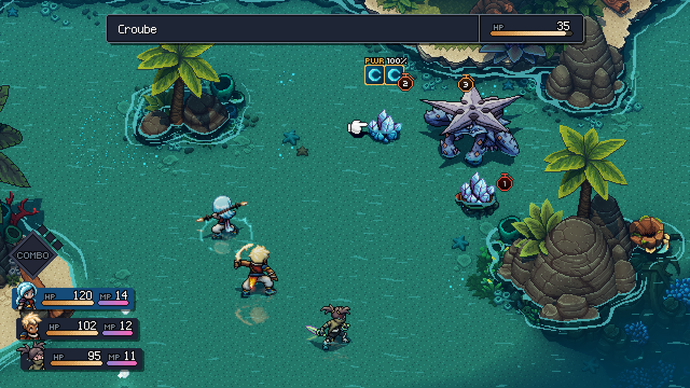
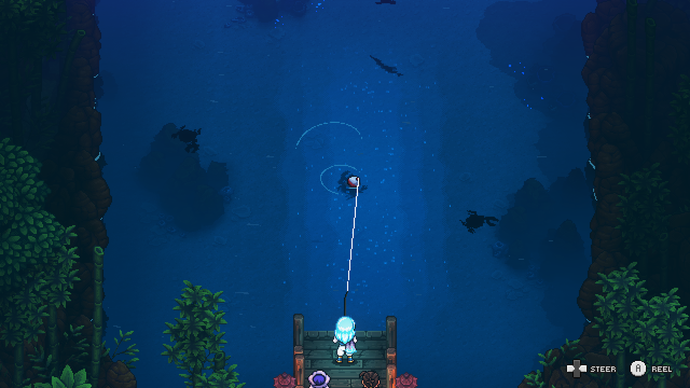
Something rare actually happened to me while playing Sea of Stars. The big bad’s lair opens up near the end, but instead of entering the towering structure to finish the fight, I stopped, turned, retraced my steps. Using my trusty ship to recross oceans, I went back to find those mysteriously sealed ancient doors, those interesting landmarks sunk beneath the water, those almost-forgotten treasure chests I previously couldn’t reach.
And through doing so, sure, I found the expected super bosses and legendary weapons, but I also discovered another maybe-not-intentional reference; this time to Final Fantasy IV’s changing world. I was rediscovering the world anew – it had changed in large and little ways. Buildings that had been under construction for a dozen hours were finished. NPCs that were once silent had entirely new requests for me. Sitting with the game longer than I needed to revealed many things, but mainly that when something is made with love, that love surfaces in the smallest flourishes.
- SEO Powered Content & PR Distribution. Get Amplified Today.
- PlatoData.Network Vertical Generative Ai. Empower Yourself. Access Here.
- PlatoAiStream. Web3 Intelligence. Knowledge Amplified. Access Here.
- PlatoESG. Automotive / EVs, Carbon, CleanTech, Energy, Environment, Solar, Waste Management. Access Here.
- PlatoHealth. Biotech and Clinical Trials Intelligence. Access Here.
- ChartPrime. Elevate your Trading Game with ChartPrime. Access Here.
- BlockOffsets. Modernizing Environmental Offset Ownership. Access Here.
- Source: https://www.eurogamer.net/sea-of-stars-review
- 20
- 30
- 7
- a
- About
- above
- absolutely
- accessibility
- across
- Action
- active
- actually
- add
- added
- ADDITION
- aforementioned
- after
- Against
- All
- along
- also
- Although
- always
- an
- ancient
- and
- Animation
- animations
- Another
- any
- apart
- approach
- ARE
- AREA
- arguably
- around
- as
- At
- attention
- AUGUST
- authors
- back
- background
- bad
- balancing
- ball
- Battle
- battles
- battling
- BE
- beautiful
- because
- become
- Bedtime
- been
- beginning
- behind
- BEST
- between
- BIG
- Blade
- blender
- Blue
- Blue Dragon
- board
- board game
- Boomerangs
- Boost
- bought
- Breaking
- Building
- Bunch
- Bundle
- but
- button
- by
- camping
- CAN
- Cap
- care
- Catch
- Cave
- challenges
- changed
- changing
- channels
- character
- characters
- charging
- child
- Children
- choices
- Choosing
- Chrono Trigger
- class
- classics
- clear
- closely
- club
- cocktail
- combat
- Comedy
- complex
- conflict
- constant
- constantly
- construction
- contemporary
- content
- controls
- cookie
- cookies
- couldn
- countdown
- covers
- create
- created
- Creating
- credit
- curtain
- Cute
- damage
- damaging
- decision
- defensive
- derivative
- despite
- destined
- detail
- Developer
- different
- difficulty
- dire
- directions
- discovered
- Disrupt
- do
- does
- doesn
- doing
- don
- done
- doors
- dozen
- Dragon
- dramatic
- drastically
- During
- each
- Edge
- effects
- efficient
- enable
- end
- Endlessly
- engaging
- enough
- entering
- entirely
- Epic
- Eurogamer
- even
- events
- ever-growing
- Every
- examine
- Example
- existence
- expect
- expected
- experience
- explore
- Exploring
- extends
- Face
- FANTASY
- feel
- few
- fight
- Fighting
- fights
- Final
- Final Fantasy
- find
- finish
- Fire
- firmly
- First
- first time
- fish
- follows
- For
- frequently
- fresh
- from
- full
- fun
- further
- game
- Game Pass
- Games
- Gaming
- GDPR
- Get
- giant
- give
- given
- Glass
- goes
- GOG
- good
- great
- Green
- Group
- had
- half
- Handy
- happen
- happened
- Hard
- has
- head
- Health
- heavy
- help
- her
- here
- hidden
- High
- him
- his
- HIT
- hour
- hours
- House
- How
- HTTPS
- i
- if
- Illusion
- importance
- importantly
- in
- influence
- Inspiration
- instance
- instead
- interested
- interesting
- into
- introduction
- invested
- invite
- Is
- IT
- ITS
- Job
- join
- jump
- just
- kiss
- know
- large
- launch
- LEARN
- least
- left
- Legendary
- less
- Level
- level cap
- level up
- like
- Little
- lives
- locations
- locked
- Locks
- longer
- Look
- looking
- looks
- lost
- love
- made
- Magic
- mainly
- Majority
- make
- MAKES
- Making
- manage
- mansion
- many
- Mario
- mark
- mask
- Match
- maybe
- me
- meaning
- meet
- member
- Merry
- Message
- mix
- Modern
- moments
- mood
- Moon
- more
- most
- mostly
- Mountain
- move
- movement
- much
- my
- navigate
- Near
- nearly
- need
- needed
- needs
- never
- New
- Next
- Nice
- no
- not
- notes
- now
- number
- numbers
- obvious.
- oceans
- of
- off
- often
- Old
- on
- once
- One
- only
- onto
- opens
- opportunities
- Options
- or
- order
- Other
- our
- out
- over
- own
- particularly
- Party
- pass
- Past
- PC
- perhaps
- pipes
- Pixel
- placements
- plato
- plato data intelligence
- platodata
- platogaming
- played
- Playing
- playstation
- please
- Plus
- Points
- Pools
- Portal
- positioning
- power
- precious
- present
- pretty
- previously
- probably
- Problem
- purpose
- quite
- racing
- Rare
- RE
- reach
- Real
- really
- recent
- removed
- requests
- requires
- result
- resulting
- Revealed
- review
- right
- Rooms
- round
- RPG
- RPGs
- s
- same
- saving
- scenes
- SEA
- Sea of Stars
- second
- see
- seemingly
- seen
- Series
- set
- sets
- settings
- several
- she
- shot
- show
- side
- significantly
- Signs
- since
- Sitting
- skills
- smart
- SNES
- So
- some
- something
- Soon
- spend
- Spot
- stakes
- standard
- Stars
- stats
- Status
- step
- Steps
- Stone
- Strategic
- strong
- structure
- studio
- such
- summer
- super
- sure
- surprising
- sword
- synopsis
- system
- Systems
- Take
- talk
- targeting
- teenager
- than
- thanks
- that
- The
- The Game
- the world
- their
- Them
- theme
- themselves
- then
- there
- These
- they
- thing
- things
- this
- those
- though
- Through
- Thus
- ticking
- time
- to
- together
- too
- tools
- totally
- trailer
- transforms
- trigger
- true
- try
- turn
- turned
- turns
- Twice
- two
- types
- under
- underwater
- unfriendly
- unique
- unlocked
- up
- us
- using
- vast
- ve
- very
- via
- Video
- View
- Vulnerable
- wants
- was
- Water
- way
- ways
- we
- weapons
- well
- went
- were
- What
- when
- where
- while
- WHO
- why
- window
- Winter
- with
- world
- worth
- wrapped
- X
- xbox
- xbox series
- years
- yes
- yet
- you
- your
- yourself
- youtube
- zephyrnet
